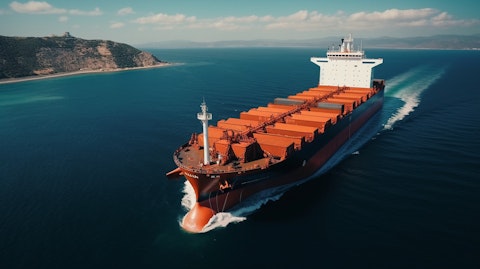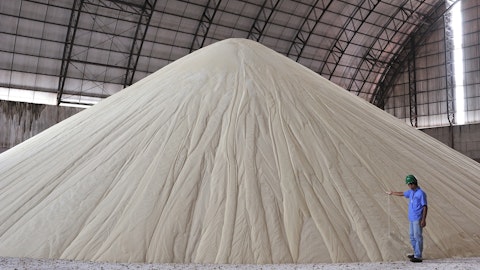In this article, we will look at the 20 countries with the highest tariffs. If you want to skip the detailed analysis head straight to the 5 Countries With the Highest Tariffs.
World Trade Outlook
The international trade industry logged consistent growth in 2020, with the global merchandise trade reaching $19.48 trillion, according to a report from the World Trade Organization (WTO). Emerging markets and developing economies have experienced significant trade growth. In 2020, the global merchandise trade in developing economies soared from 39% in 2000 to 47% in 2019. As per the WTO’s October 2023 Global Trade Outlook, the world trade and output slowed abruptly in the fourth quarter of 2022 driven by tighter monetary policy of major economies including the US and European Union. There was hope following the reopening of China and falling energy prices, but things went the other way. China suffered a massive property market crisis followed by deflation. China is one of the largest economies in the world with deflation or dangerously low inflation. Whereas, the US and European Union face high inflation. World trade has suffered from the after-effects of the Russia-Ukraine war and Israel’s terrorizing attacks on Gaza. These two invasions have influenced the overall outlook for trade in 2024.
The WTO expects world trade to grow up to 3.3% in 2023. However, the International Monetary Fund (IMF), the European Commission, the OECD, and the World Bank forecast the 2024 annual growth rate of world trade to be around 3.5%, 3%, 2.7%, and 2.8%, respectively. Asia is expected to be the fastest growing region with exports and imports forecast at 5.1% and 5.8%. The Commonwealth of Independent States (CIS) is projected to be the most impacted region with exports and imports forecast of 1.9% and -4%, respectively. World trade is aiming to be more sustainable and it is gaining prominence. According to a report by Fortune Business Insights, the global sustainable packaging market is projected to reach $518.33 billion by 2030 from an estimated $329.26 billion in 2023, growing at a compound annual growth rate of 6.70%.
The biggest threat to world trade is the Yemen-based, Iran-backed Houthi attacks on the ships of Israel and its allies. The Yemeni rebel group is blocking one of the major shipping routes for global trade, the Red Sea. Nearly 12% of the world’s shipping passes through the Red Sea. On January 13, Al Jazeera reported that traffic through the Red Sea has dropped by more than 40%, disrupting global supply chains. On average around 50 ships per day pass through the Red Sea, accounting for $3 billion to $9 billion worth of cargo. The total amount of goods shipped through the route is approximately estimated at over $1 trillion each year. Since mid-November 2023, the Yemeni Houthis have attacked more than a dozen commercial ships in the Red Sea. Some of the leading shipping companies that have rerouted their vessels around the Cape of Good Hope on the southern tip of Africa include A.P. Møller – Mærsk A/S (CPH:MAERSK), Evergreen Marine Corp Taiwan Ltd (TPE:2603), Mediterranean Shipping Company (MSC), and CMA CGM, among others. The rerouting of vessels around the Cape of Good Hope is delaying delivery times, adding a further 6,000 km to their route.
Shipping Companies Working on Advancing Global Trade
A.P. Møller – Mærsk A/S (CPH:MAERSK), Evergreen Marine Corp Taiwan Ltd (TPE:2603), and COSCO SHIPPING Holdings Co., Ltd. (OTC:CICOY) are some of the leading shipping companies in the world that are working on new innovations to boost global trade.
A.P. Møller – Mærsk A/S (CPH:MAERSK), or Maersk, is a Danish shipping and logistics company. On February 12, A.P. Møller – Mærsk A/S (CPH:MAERSK) announced its new digital solution for customers who opt for air freight solutions. The new solution will require a simple online tool to book air cargo freight with instant prices for over 70,000 connections across global airports. Air freight is a swift means of global transportation that avoids challenges faced through sea shipment. Here is what a representative from Mærsk said:
“Today, manufacturing has truly diversified with global value chains. We are noticing that customers sitting in one part of the world need to move raw material from origin to destination without being at either of the locations. Our digital air freight solution allows them to make such bookings seamlessly.”
Evergreen Marine Corp Taiwan Ltd. (TPE:2603) is a leading container transportation and shipping corporation based out of Taiwan. On February 27, the company announced that it has extended its cooperation with Ocean Alliance for five more years to March 31, 2032. Based on the renewed agreement, Evergreen Marine Corp Taiwan Ltd. (TPE:2603) can extend the collaboration for a further five years to 2037 depending on additional requirements. With the renewal of this agreement, Ocean Alliance members will continue to provide their customers with stable and high-quality shipping services.
COSCO SHIPPING Holdings Co., Ltd. (OTC:CICOY) is China’s top international shipping company. On March 17, COSCO SHIPPING Holdings Co., Ltd. (OTC:CICOY) announced that it has incorporated the Global Shipping Business Network (GSBN) in Hong Kong. GSBN has initiated operations to accelerate the digital transformation of the shipping industry. The establishment of GSBN will allow global trade stakeholders to improve operations, increase delivery reliability, and adapt to digital transformation.
With this context, let’s take a look at the 20 countries with the highest tariffs.

20 Countries With the Highest Tariffs
Our Methodology
To compile our list of the countries with the highest tariffs, we shortlisted the 20 countries by tariff rate from the World Bank. The countries are ranked in ascending order of their tariff rates. For the countries with similar tariff rates, we have used the trade percentage of the GDP as a tie-breaker. The country with a higher trade percentage of the GDP is ranked higher on our list. The data for the trade percentage of the GDP is also taken from the World Bank. In addition, we have mentioned the GDP (PPP) of countries, as of 2024, and the data is taken from the International Monetary Fund (IMF) database.
20 Countries With the Highest Tariffs
20. Guinea
Tariff Rate (2020): 12.20%
Trade % of GDP (2022): 107%
Guinea is a country located in West Africa and has a GDP of $52.65 billion, as of 2024. Guinea’s trade accounted for 107% of the country’s GDP in 2022 and it had a tariff rate of 12.20% in 2020. Guinea ranks 20th among the countries with the highest tariffs.
19. Nigeria
Tariff Rate (2020): 12.40%
Trade % of GDP (2021): 22.58%
Nigeria is one of the largest economies in Africa having a GDP of $1.44 trillion, as of 2024. Nigeria had a 12.40% tariff rate in 2020 and the country boasted a 22.58% trade-to-GDP ratio in 2021.
18. Vanuatu
Tariff Rate (2020): 12.70%
Trade % of GDP (2022): 69%
Vanuatu is a country situated in the South Pacific Ocean and has a GDP of $1.03 billion, as of 2024. With a tariff rate of 12.70% in 2020, Vanuatu ranks among the countries with the highest tariffs.
17. Antigua and Barbuda
Tariff Rate (2020): 13.10%
Trade % of GDP (2022): 118%
Antigua and Barbuda is an island country located in the Caribbean. Antigua and Barbuda had a tariff rate of 13.10% in 2020 and trade accounted for 118% of the country’s GDP in 2022. The island country has a GDP of $2.80 billion and is one of the countries that has the highest tariff rates in the world.
16. Solomon Islands
Tariff Rate (2020): 13.60%
Trade % of GDP (2020): 60%
The Solomon Islands is a country that consists of several islands. The Solomon Islands had a tariff rate of 13.60% in 2020 and has a GDP of $1.87 billion, as of 2024.
15. Venezuela
Tariff Rate (2020): 14.10%
Trade % of GDP (2017): 67%
Venezuela is a struggling economy and has a GDP of $226.48 billion. With a tariff rate of 14.10% in 2020, Venezuela ranks 15th among the countries with the highest tariffs.
14. Sierra Leone
Tariff Rate (2020): 14.10%
Trade % of GDP (2022): 88%
Sierra Leone has a GDP of $19.05 billion and the country’s trade activity represented 88% of its GDP in 2022. Sierra Leone had a tariff rate of 14.10% in 2020 and is one of the countries with the highest tariff rates globally.
13. Nauru
Tariff Rate (2020): 14.40%
Trade % of GDP (2022): 170%
Nauru is an island country located in the northeast of Australia and has a GDP of $150 million, as of 2024. Nauru had a 14.40% tariff rate in 2020 and ranks among the countries with the highest tariffs.
12. Gabon
Tariff Rate (2019): 14.50%
Trade % of GDP (2022): 78%
Gabon has a GDP of $43.97 billion, as of 2024, and trade accounted for 78% of the country’s GDP in 2022. Gabon had a tariff rate of 14.50% in 2019 and is one of the countries that has the highest tariff rates in the world.
11. Cameroon
Tariff Rate (2019): 15.46%
Trade % of GDP (2022): 41%
Cameroon is a country located in Central Africa and has a GDP of $142.05 billion. Cameroon’s trade accounted for 41% of the country’s GDP in 2022 and had a tariff rate of 15.46% in 2019. Cameroon ranks among the countries with the highest tariffs.
10. Equatorial Guinea
Tariff Rate (2007): 15.60%
Trade % of GDP (2022): 88%
Equatorial Guinea ranks 10th among the countries with the highest tariffs. Equatorial Guinea had a tariff rate of 15.60% in 2007 and has a GDP of $27.41 billion, as of 2024.
9. Central African Republic
Tariff Rate (2017): 16.40%
Trade % of GDP (2022): 45%
The Central African Republic is one of the poorest countries in the world and has a GDP of around $5.95 billion. The Central African Republic had a tariff rate of 16.40% in 2017 and the country’s trade-to-GDP ratio was around 45% in 2022.
8. Chad
Tariff Rate (2016): 16.40%
Trade % of GDP (2022): 91%
Officially the Republic of Chad is a landlocked country at the crossroads of North and Central Africa. Chad had a tariff rate of 16.40% in 2016 and has a GDP of $34.35 billion, as of 2024.
7. Fiji
Tariff Rate (2020): 16.60%
Trade % of GDP (2022): 117%
Fiji is located in the South Pacific and has a GDP of $16.10 billion. Fiji had a tariff rate of 16.60% in 2020 and ranks among the countries with the highest tariffs.
6. Cayman Islands
Tariff Rate (2016): 16.70%
Trade % of GDP (2020): 106%
The Cayman Islands is an island country located in the western Caribbean Sea and had a tariff rate of 16.70% in 2016. The Cayman Islands’ trade represented 106% of the country’s GDP in 2020.
Click to continue reading and see the 5 Countries With the Highest Tariffs.
Suggested Articles:
- Top 20 Chemical Exporting Countries in the World
- Top 20 Mineral Importing Countries in the World
- Top 25 Richest Women in the World in 2024
Disclosure: None. 20 Countries With the Highest Tariffs is originally published on Insider Monkey.





